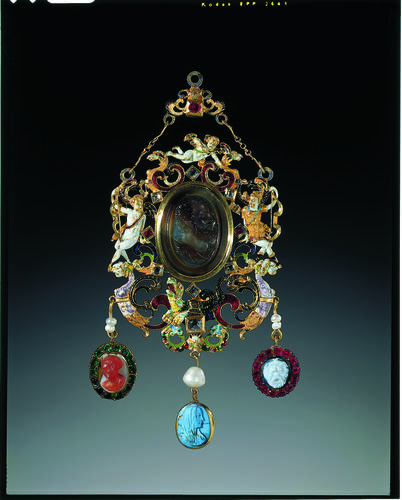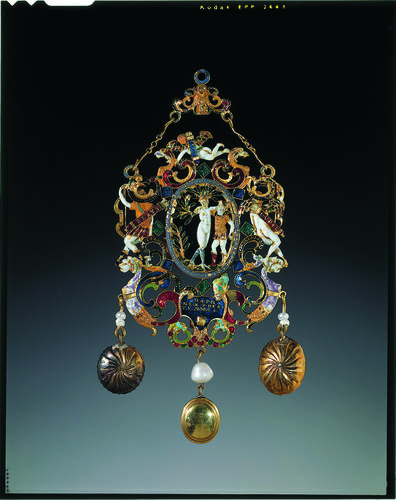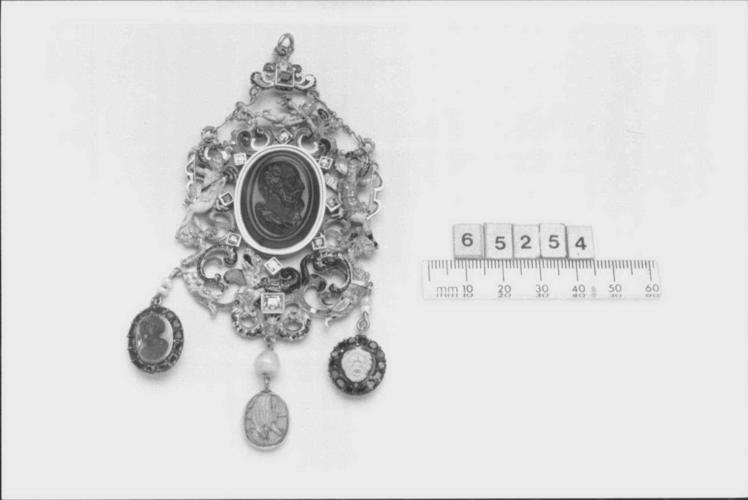Apollo and Daphne pendant jewel 2nd half 16th c. with 18th c. additions
Gold, émail en ronde bosse, sard, orange and white sardonyx, black and white onyx, table-cut diamonds, table-cut and cushion-cut rubies, cushion-cut Colombian emeralds, turquoise, saltwater pearl | 11.8 x 5.5 cm (whole object) | RCIN 65254




-
Obverse: a sard cameo representing a bearded male head, in profile to the right; with surrounding open scrollwork frame set with seven table-cut diamonds and two rubies and incorporating: to the left, a reclining figure of Cupid; to the right, Apollo with Cupid in flight above and a dragon flanked by two harpy terms below.
Reverse: central enamelled openwork plaque with full-length figures of Apollo and Daphne with surrounding scrollwork frame; the quivers on the reverse of the figures of Apollo and Cupid to the left and right and of Cupid above bear the inscriptions FEBUS, CUPID and CPID respectively; a cartouche below bears the inscription: DAPH NEM:PHEB US:AMAT (Apollo loves Daphne).
The jewel is suspended from two chains that converge in a scrollwork suspension loop set with a ruby. Three pendants are suspended from the lower edge of the jewel. To the left, a sardonyx cameo with a female bust in three-quarter profile to the left, framed by fourteen emeralds set in closed gold mount with two small pearls above; in the centre, a turquoise cameo representing a draped female bust, in profile to the right, in closed gold mount with large pearl above; to the right an onyx cameo with the head of Bacchus en face, framed by fourteen rubies in closed gold mount with two small pearls above.
The pendant probably originally signified unrequited love, its full meaning conveyed by a central scene - perhaps a miniature - in a locket that has subsequently been replaced by the late eighteenth century sard cameo. It was added to the jewel, together with the gold frame, at the same time as the three cameo pendants. These probably replaced the original pearl pendants. Those to the left and right appear to be sixteenth century and are in contemporary mounts with mid-eighteenth century backings; that in the centre is probably seventeenth century. These three cameos give a terminus post quem for their addition to the jewel: they were all in the collection of Consul Joseph Smith of Venice, acquired by George III in 1762. They have been identified as that to the left as Crispina Augusta, to the right as Silenus and the central cameo as Paulina Augusta. The last-named probably represents the head of the Virgin.
The transformation of the jewel, when the pendant cameos and the coarse hooks with the pearls were added, probably took place during the reign of George IV. No record of the jewel entering the Royal Collection has so far been discovered. Its place of origin also remains uncertain although there is a suggestion that it is mid-sixteenth century Italian but there is no comparable material to sustain this dating and attribution. The elegant style and the Mannerist character of the allusions suggest a court workshop. France is also a likely choice but the piece may have been executed in England.
The jewel is probably identifiable amongst the items in the following extract from the 1830 inventory of jewels at Windsor Castle: ‘24 d° [cameos] including 2 large jewels in one of which are 13 cameos and in the other a few diamonds and small pearls’.
Text adapted from Ancient and Modern Gems and Jewels in the Collection of Her Majesty The Queen, London, 2008Provenance
Joseph Smith, Venice; from whom pendant cameos acquired by George III in 1762. Probably identifiable from the 1830 inventory of jewels at Windsor Castle: '24 d° [cameos] including 2 large jewels in one of which are 13 cameos and in the other a few diamonds and small pearls' (WCIJ 1830 f.38).
-
Medium and techniques
Gold, émail en ronde bosse, sard, orange and white sardonyx, black and white onyx, table-cut diamonds, table-cut and cushion-cut rubies, cushion-cut Colombian emeralds, turquoise, saltwater pearl
Measurements
11.8 x 5.5 cm (whole object)
2.7 x 2.1 cm (excluding fittings)
60 mm (Width) x 11 mm (Depth); 129 mm (Length); 76 g (Weight) (whole object)








